Part of a series of articles titled Alaska Park Science - Volume 17, Issue 1. Migration: On the Move in Alaska.
Article
Pleistocene Megafauna in Beringia
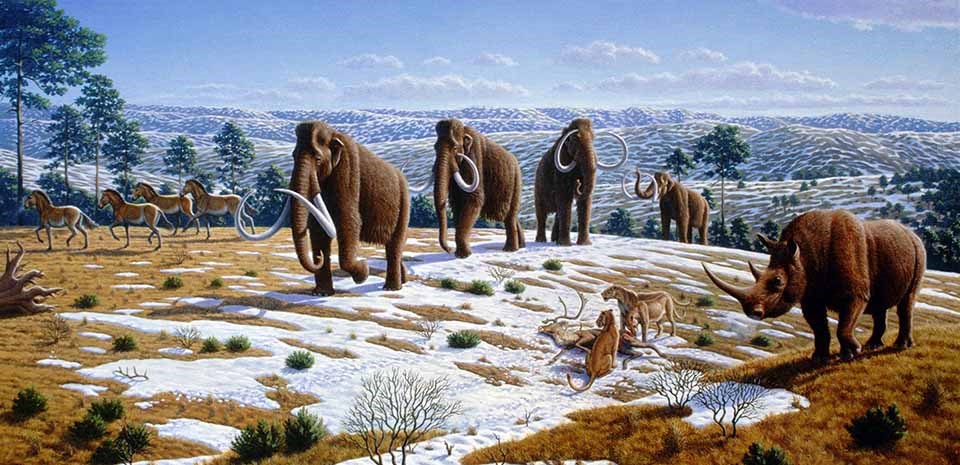
Image courtesy of Mauricio Antón
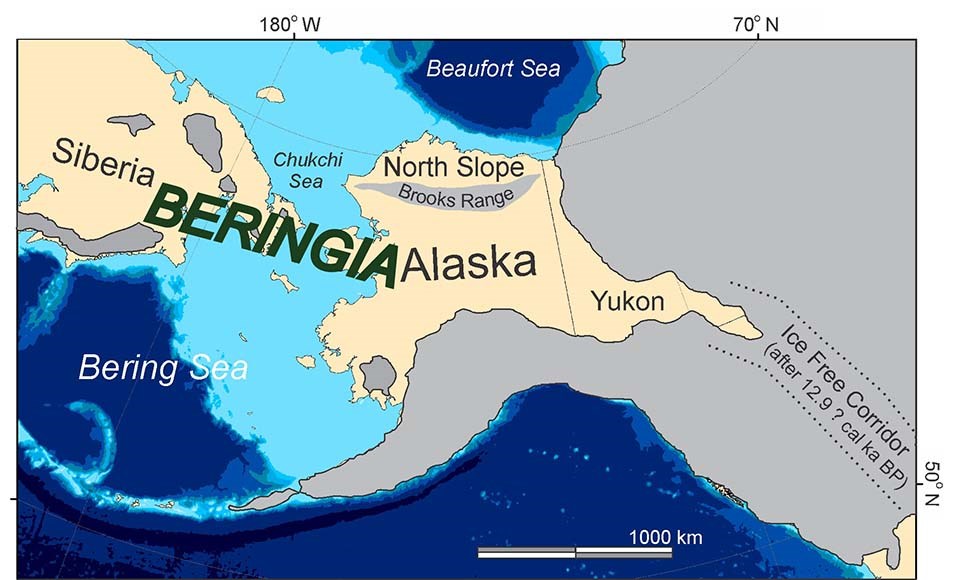
Beringia’s ice-age (Pleistocene) iconic mega-fauna (mammals >100 lbs or 45 kg) included the mastodon (Mammut americanum), woolly mammoth (Mammuthus primigenius), woolly rhino (Coelodonta antiquitatis), lion (Panthera spelaea), and short-faced bear (Arctodus simus), all of which are now extinct. Quite common were horses (Equus spp.), similar to but smaller than our modern horses (Equus caballus), and a species of bison, the steppe bison (Bison priscus), that is now extinct but was the ancestor to our modern plains bison (Bison bison). Cattle similar to the modern yak (Bos grunniens) grazed in Siberia and interior Alaska. Finally, there were species that are still alive today including muskox (Ovibos moschatus), caribou (Rangifer tarandus), mountain sheep (Ovis dalli and nivicola), saiga (Saiga tatarica), brown bears (Ursus arctos), and wolves (Canis lupus). Moose (Alces alces), elk (Cervus elaphus), and humans (Homo sapiens) were not present in eastern Beringia until the ice age was waning, perhaps 14,000 years ago.
Ice Age Beringia was very different from modern Beringia. The Arctic is depauperate of megafauna today. Estimates of Pleistocene megafaunal biomass are about 100 times greater than today’s (Zimov et al. 2012, Mann et al. 2013). If one were to wander around Beringia today, one might observe some caribou, or a few moose, sheep in the mountains, and wolves and bears. Muskoxen seen on the tundra today are descendants of muskoxen reintroduced in the 1930s and 1970s, decades after the last indigenous muskoxen of Beringia died off in the 1800s.
Given such dramatic changes, there are some questions to ask about Ice Age Beringia: How do we know those megafauna lived there? When did they live there? Why did they live there? And what happened to all of them?
How Do We Know All Those Animals Lived There?
Being so far north, Beringia is its own deep freezer and has preserved the remains of many of its former inhabitants. The most dramatic finds have been in western Beringia, in Siberia, where mummies and skeletons of extinct Pleistocene mammals have been discovered (Figure 2). Mummies and skeletons are not as common in eastern Beringia, but in the 1980s, a steppe bison mummy was found near Fairbanks (Guthrie 1990). The mummy, named Blue Babe, is now on display at the University of Alaska Museum (Figure 2).

Far more common are individual bones of these mostly vanished animals. These bones are not mineralized fossils like most dinosaur remains, but are still bone, sometimes with marrow inside. Because the bones have been frozen, they tend to be well-preserved and are suitable for various isotopic and DNA analyses. Miners across Beringia routinely expose bones of Pleistocene megafauna in their search for mineral treasures. Some rivers also expose bones as they meander back and forth across their valleys. Bering Land Bridge National Preserve in northwestern Alaska and other parks in Alaska have been the sources of many Pleistocene bones. Most of these bones are disarticulated, individual bones, although rarely skeletons are found such as “Bison Bob” in northern Alaska in 2012 (Figure 2). Over decades, many of these bones have been collected and deposited in museums where they are studied by paleontologists.
By simply identifying the bones, we can learn what species were present and relative abundance of those species across different environments. From this it is immediately apparent that Beringia was not one vast homogenous ecosystem, but was made up of diverse ecosystems. For example, during the late Pleistocene (about 45,000-11,700 years ago) in Siberia, caribou was the most common species followed by horse and bison, whereas in northern Alaska, the horse was most common followed by bison and caribou, and in interior Alaska, bison dominated the landscape followed by horse and mammoth (Figure 3; Guthrie 1968, Zimov et al. 2012, Mann et al. 2013).

When Did They Live There?
There are two main ways of determining when an animal lived. Remains may be found embedded in layers of undisturbed geologic sediments. Some of these layers, such as volcanic ash, are very distinctive and their ages can be established, and thus those of the remains as well. For bones not in stratigraphic context, we can analyze small pieces of bone using radiocarbon (14C) analysis to measure the amount of carbon 14 isotopes in bones and estimate how long ago the animal died. This 14C analysis is effective for bones up to about 45,000 years old; older bones do not retain enough carbon to be dated using this method. Unfortunately, there are no effective techniques for dating bones older than this. Not all bones collected have been dated, because 14C analysis costs hundreds of dollars per sample.
Almost all the dates obtained on Pleistocene-era Beringian remains are from disarticulated bones and thus are from 14C analysis. Consequently, most of our information on ages of Beringian megafauna is from the late Pleistocene. Hundreds of 14C-dated bones from northern Alaska show that in addition to being spatially diverse, relative abundances of different species changed over time. In particular, the relative numbers of horse and bison changed throughout the last 45,000 years (Figure 4) suggesting that climatic and environmental fluctuations differentially favored some species over others (Mann et al. 2015).
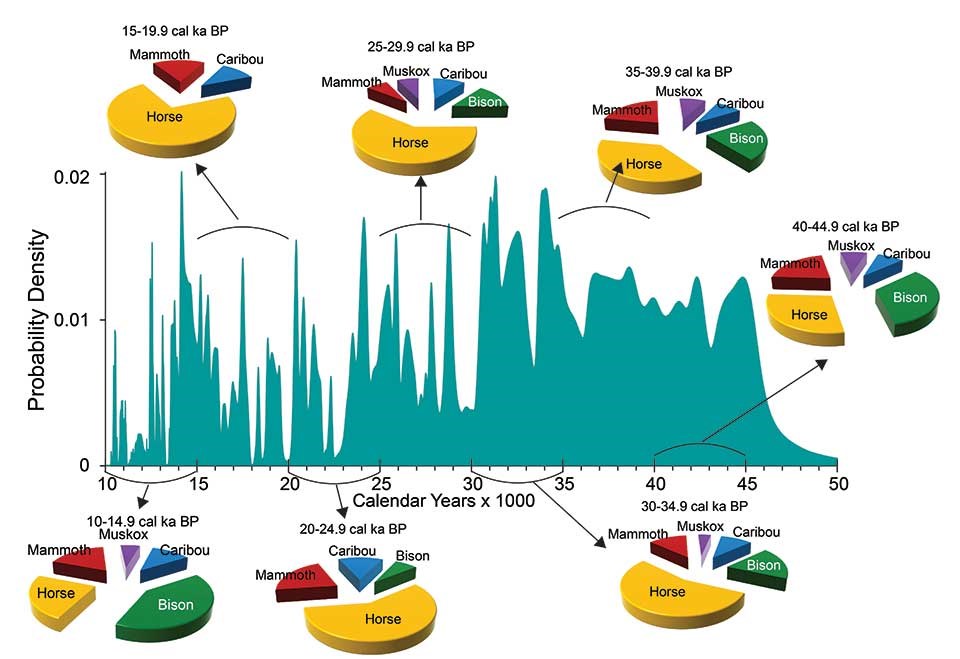
Why Did the Megafauna Live There?
Modern Beringia is covered by vast expanses of permafrost, peat, spongy tundra vegetation, and boreal forests of mostly coniferous trees. Much of it is buried in snow over half the year and during the cool, wet summer, it swarms with mosquitoes. This modern ecosystem supports a fraction of the animals that lived there during the Pleistocene. So, what was different? Not surprisingly, the climate was generally colder and drier during most of the Pleistocene, which would seem to make it less hospitable to megafauna. Because sea level was so much lower, the land mass of Beringia was larger and included the expansive Bering Land Bridge. This resulted in a more continental climate with little precipitation and clear skies: conditions that produced a unique biome called the Mammoth Steppe (Guthrie 1990), unlike anything found in Beringia now. The climate was too cold for trees and the dry conditions favored steppe-like grasslands, which provided abundant food for grazing megafauna; the late-Pleistocene megafauna were grazers and not browsers (or wood-eaters). The dry grasslands and low snow levels also provided a firm substrate that was easy for the hooved animals to walk over throughout the year.
The Mammoth Steppe was a complex biome that changed over time and across the region. This resulted in a mosaic-like ecosystem that varied in response to a constantly changing climate. During the Pleistocene, the climate changed much more dramatically than it has during the last 10,000 years, the period known as the Holocene, a remarkably stable climatic period compared to the preceding million years or so. The unstable climate of the Pleistocene caused rapid changes in the plant communities and thus forage for megafaunal herbivores. Abundance and distributions of these animals would have varied in response to the changes. Being large, the megafauna would have been able to move across the landscape tracking favorable patches of habitat both seasonally and over longer time scales.
Because of low snow levels and clear weather, green-up would have been earlier than now so the Mammoth Steppe growing season was probably longer. The clear skies of a continental climate may have allowed warmer temperatures during the growing season than occur with modern cloudier weather (Guthrie 2001). Mammoth Steppe soils were therefore dryer, warmer, and more fertile than now (Young 1982, Walker et al. 2001). This would have enhanced plant productivity and megafauna, that could graze around the clock, and could grow larger during the summer. With the nutritious plant growth, the megafauna also would have been able to consume enough in the summer to put on reserves to help them survive the long, cold winter.
This was a complete ecosystem of megafauna with herbivores and the predators that consumed them. Like most ecosystems, there were many more herbivores than carnivores. The giant short-faced bears may have mostly scavenged already-dead herbivores (Matheus 1995), but brown bears, lions, and wolves undoubtedly hunted and killed their prey. Radiocarbon dates suggest the lions may have specialized in hunting horses (Mann et al. 2013).
What Happened to All of Them?
The Mammoth Steppe ecosystem vanished at the end of the Pleistocene. Some experts argue that humans are responsible for the megafaunal extinctions (Alroy 2001), but across Beringia, we know that humans co-existed with the extinct species for long periods. Documented 14C dates show that humans in Alaska overlapped with horse, bison, and lions for >1,000 years and also probably with mammoths, and we lack evidence of overhunting of these animals (Mann et al. 2013). The region of Beringia is vast and the early human population was small. A more likely explanation for the extinctions is that the prolonged warming at the end of the Pleistocene caused environmental changes that did not favor the Mammoth Steppe megafauna.
When the climate warmed, it became wetter. Shrubs would have invaded the region and replaced the grasslands. Many shrubs have chemicals that protect them from herbivore browsing and they are not suitable food for grazing animals. As the glaciers melted and sea level rose, the climate would have become more maritime, with increased precipitation and cloud cover. Despite the overall warming trend, the summer growing season would have been wetter, shorter, and probably cooler due to decreased sunshine (Guthrie 2001). As these changes persisted, peat would have spread across the landscape and negatively affected megafauna. Peat is not a nutritious food and it insulates the ground promoting the spread of permafrost, creating a waterlogged, inedible substrate.
The spongey substrate and deeper winter snows would have negatively impacted the megafauna. Most megafauna would have had difficulty walking through deep snow or over spongey ground because of their small feet relative to heavy body weight (high foot loading). They would have had to expend more energy walking at the same time that food resources were becoming scarcer. The megafaunal herbivores that disappeared from Beringia had high foot loadings, whereas caribou and muskox that survived the changes to the modern climate have low foot loadings, making it easier for them to move across the present landscape. Moose and humans who moved into the region as the shrubs invaded also have lower foot loadings than the extinct megafauna (Guthrie 1990; Figure 5).
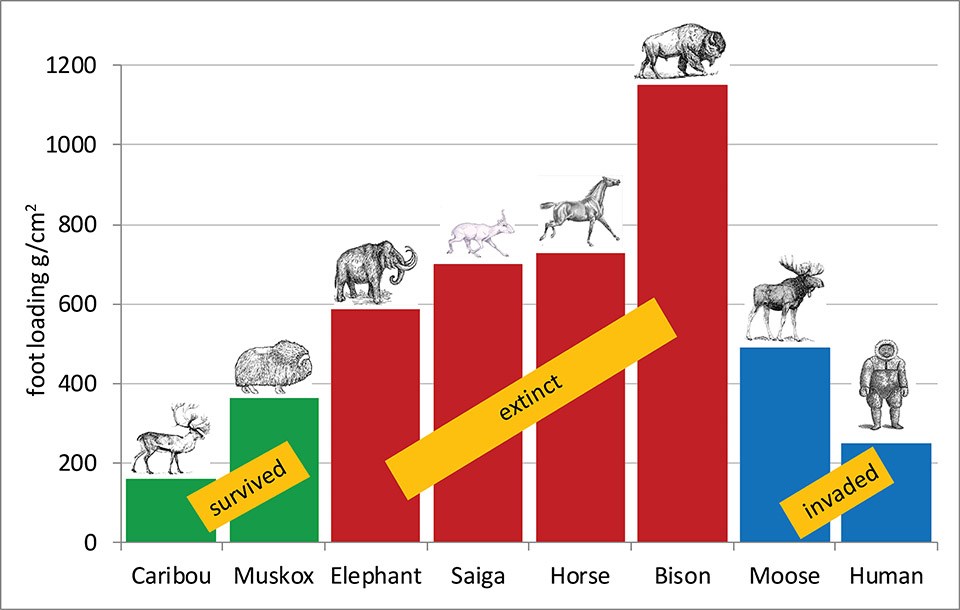
The changing vegetation would have meant the diets of the grazers would have changed. Analyses of nitrogen and carbon isotope ratios in bones reflect the diet and amount of moisture the animal was consuming. By comparing isotope values in bones over time, it is possible to detect changing patterns in diet. A survey of bone isotope values at the peak of the ice age shows that bison, horse, and mammoth were consuming a different diet from caribou and muskox that were selecting plants that favored warmer and wetter environments. The dietary difference became more pronounced as the climate warmed (Mann et al. 2013; Figure 6). Species that survived the end of the ice age had probably selected plant communities that would thrive in the post-Pleistocene climate throughout the ice age. It is interesting to note that caribou and muskoxen not only had a diet that favored the changing environment, but they had low foot loadings, which also favored the new environment.
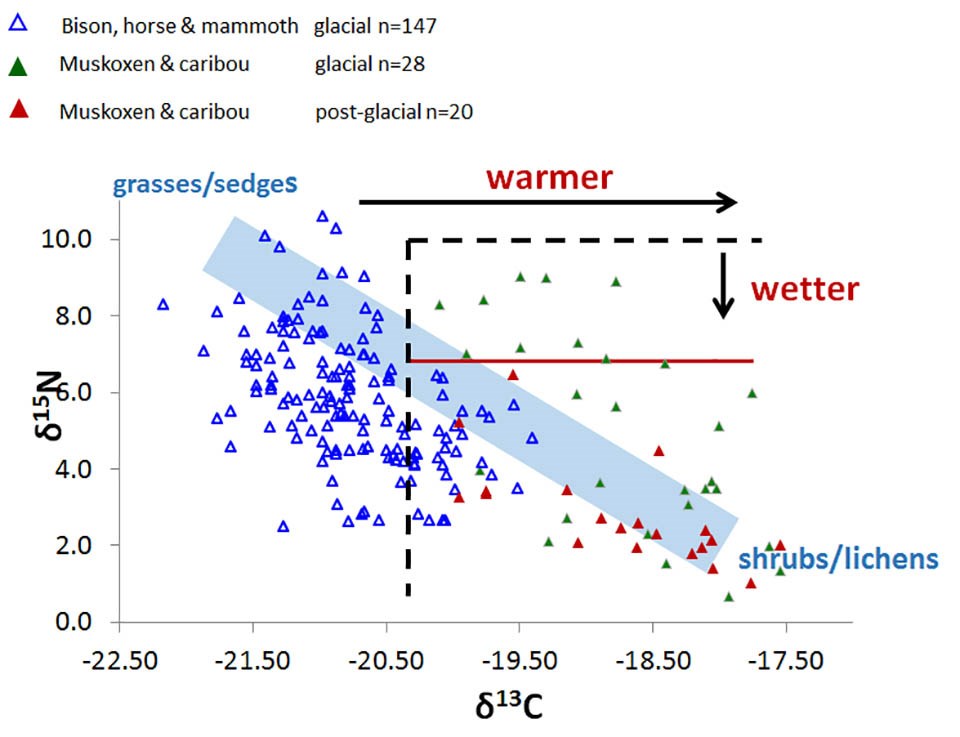
Thus, as the climate continued to remain warm, Pleistocene megafauna would have been confronted with food scarcity and increasingly difficult travel due to the boggy ground during summer and deep snow conditions during winter. These environmental changes would have been compounded by shorter growing season and rising sea level culminating in the closing of the Bering Land Bridge and a reduction in grazing area. The disappearance of herbivores affected the specialized predators—short-faced bears and lions. DNA evidence indicates that Pleistocene Beringian wolves also became extinct (Leonard et al. 2007). Wolves currently inhabiting Alaska are genetically distinct from those that lived here during the Pleistocene.
The changes at the end of the Pleistocene were not negative for all species. Caribou, muskox, sheep, and brown bears continued to inhabit the region. The establishment of shrubs prompted by the warming allowed wood-dependent species such as moose, elk, and humans to colonize Beringia. Moose and elk are browsers and require woody plants for their diets. The early humans in Beringia depended on wood both for fuel and as a building material.
Modern Beringia is inhabited by a small subset of the Pleistocene megafauna adapted to survive in this altered landscape. Diversity and abundance of these animals is lower in today’s Beringia, which is now dominated by peat, boreal forests, permafrost, and extreme seasonal weather.
REFERENCES
Alroy, J. 2001.
A Multispecies Overkill Simulation of the End-Pleistocene Megafaunal Mass Extinction. Science 292: 1893-1896.
Chang, D., M. Knapp, J. Enk, S. Lippold, M. Kircher, A. Lister, R. D. MacPhee, C. Widga, P. Czechowski, and R. Sommer. 2017.
The evolutionary and phylogeographic history of woolly mammoths: a comprehensive mitogenomic analysis. Sci Rep 7: 44585.
Elias, S. A. and B. Crocker. 2008.
The Bering Land Bridge: a moisture barrier to the dispersal of steppe-tundra biota? Quaternary Science Review 27: 2473-2483.
Froese, D., M. Stiller, P. D. Heintzman, A. V. Reyes, G. D. Zazula, A. E. R. Soares, M. Meyer, E. Hall, B. J. L. Jensen, L. J. Arnold, R. D. E. MacPhee, and B. Shapiro. 2017.
Fossil and genomic evidence constrains the timing of bison arrival in North America. Proc Natl Acad Sci USA.
Guthrie, R. D. 2006.
New carbon dates link climatic change with human colonization and Pleistocene extinctions. Nature 441: 207-209.
Guthrie, R. D. 2004.
Radiocarbon evidence of mid-Holocene mammoths stranded on an Alaskan Bering Sea island. Nature 429: 746-749.
Guthrie, R. D. 2001.
Origin and causes of the mammoth steppe: a story of cloud cover, woolly mammal tooth pits, buckles, and inside-out Beringia. Quaternary Science Review 20: 549-574.
Guthrie, R. D. 1990.
Frozen Fauna of the Mammoth Steppe; the Story of blue Babe. University of Chicago Press, Chicago.
Guthrie, R. D. 1968.
Paleoecology of the large-mammal community in interior Alaska during the late Pleistocene. American Midlands Naturalist 79: 346-363.
Leonard, J. A., C. Vilà, K. Fox-Dobbs, P. L. Koch, R. K. Wayne, and B. Van Valkenburgh. 2007.
Megafaunal Extinctions and the Disappearance of a Specialized Wolf Ecomorph. Curr. Biol. 17: 1146-1150.
Mann, D. H., P. Groves, R. E. Reanier, B. V. Gaglioti, M. L. Kunz, and B. Shapiro. 2015.
Life and extinction of megafauna in the ice-age Arctic. Proc Natl Acad Sci USA 112: 14301-14306.
Mann, D. H., P. Groves, M. L. Kunz, R. E. Reanier, and B. V. Gaglioti. 2013.
Ice-age megafauna in Arctic Alaska: extinction, invasion, survival. Quaternary Science Review 70: 91-108.
Matheus, P. E. 1995.
Diet and Co-ecology of Pleistocene Short-Faced Bears and Brown Bears in Eastern Beringia. Quaternary Research 44: 447-453.
Shapiro, B., A. J. Drummond, A. Rambaut, M. C. Wilson, P. E. Matheus, A. V. Sher, O. G. Pybus, M. T. P. Gilbert, I. Barnes, J. Binladen, E. Willerslev, A. J. Hansen, G. F. Baryshnikov, J. A. Burns, S. Davydov, J. C. Driver, D. G. Froese, C. R. Harington, G. Keddie, P. Kosintsev, M. L. Kunz, L. D. Martin, R. O. Stephenson, J. Storer, R. Tedford, S. Zimov, and A. Cooper. 2004.
Rise and fall of the Beringian steppe bison. Science 306: 1561-1565.
Vartanyan, S. L., K. A. Arslanov, J. A. Karhu, G. Possnert, and L. D. Sulerzhitsky. 2008.
Collection of radiocarbon dates on the mammoths (Mammuthus primigenius) and other genera of Wrangel Island, northeast Siberia, Russia. Quaternary Research 70: 51-59.
Veltre, D. W., D. R. Yesner, K. J. Crossen, R. W. Graham, and J. B. Coltrain. 2008.
Patterns of faunal extinction and paleoclimatic change from mid-Holocene mammoth and polar bear remains, Pribilof Islands, Alaska. Quaternary Research 70: 40-50.
Walker, D. A., J. G. Bockheim, F. S. Chapin, III, W. Eugster, F. E. Nelson, and C. L. Ping. 2001.
Calcium-rich tundra, wildlife, and the Mammoth Steppe. Quaternary Science Review 20: 149-163.
Young, S. B. 1982.
The vegetation of land-bridge Beringia, in: Hopkins, D. M., Matthews, J. V., Schweger, C. E., Young, S. B. (Eds.), Paleoecology of Beringia. Acedemic Press, New York, pp. 179-194.
Zazula, G. D., R. D. E. MacPhee, J. Z.Metcalfe, A. V. Reyes, F. Brock, P. S. Druckenmiller, P.Groves, C. R. Harington, G. W. L. Hodgins, M. L., Kunz, F. J. Longstaffe, D. H. Mann, H. G. McDonald, S. Nalawade-Chavan, and J. R. Southon. 2014.
American mastodon extirpation in the Arctic and Subarctic predates human colonization and terminal Pleistocene climate change. Proc Natl Acad Sci USA 111: 18460-18465.
Zimov, S. A., N. S. Zimov, A. N. Tikhonov, and F. S. Chapin, III. 2012.
Mammoth steppe: a high-productivity phenomenon. Quaternary Science Review 57: 26-45.
Last updated: February 7, 2019
